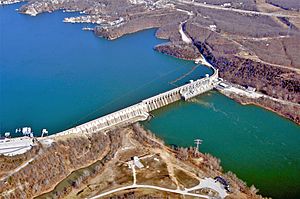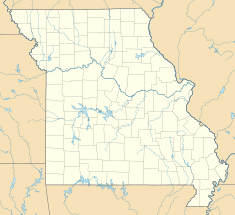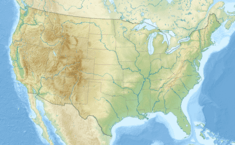Bagnell Dam facts for kids
Quick facts for kids Bagnell Dam |
|
|---|---|

Bagnell Dam
|
|
|
Location of Bagnell Dam in Missouri#USA
|
|
| Country | United States |
| Location | 617 River Road, Lakeside, Missouri |
| Coordinates | 38°12′08″N 92°37′37″W / 38.20222°N 92.62694°W |
| Purpose | Hydroelectric |
| Construction began | 1929 |
| Opening date | 1931 |
| Owner(s) | Ameren |
| Dam and spillways | |
| Type of dam | Concrete gravity |
| Impounds | Osage River |
| Height (foundation) | 148 ft (45 m) |
| Length | 2,543 ft (775 m) |
| Spillway type | Gated overflow |
| Reservoir | |
| Creates | Lake of the Ozarks |
| Total capacity | 1,927,000 acre⋅ft (2.377 km3) |
| Active capacity | 468,000 acre⋅ft (0.577 km3) |
| Catchment area | 13,944 sq mi (36,110 km2) |
| Surface area | 54,000 acres (22,000 ha) |
| Normal elevation | 660 ft (200 m) max |
| Power station | |
| Name | Osage Powerplant |
| Type | Conventional |
| Hydraulic head | 90 ft (27 m) |
| Turbines | Main: 8x 21.5 MW (33,500 HP) Francis Station service: 2x 2.0 MW (3,025 HP) Francis |
| Installed capacity | 176.0 MW 220 MW (overload) |
| Annual generation | 624,000 MWh |
|
Bagnell Dam and Osage Power Plant
|
|
| Area | 6 acres (2.4 ha) |
| Architect | Stone & Webster |
| Architectural style | Gravity Dam |
| NRHP reference No. | 08000822 |
| Added to NRHP | August 27, 2008 |
The Bagnell Dam is a large concrete dam in Missouri, United States. It holds back the Osage River to create the huge Lake of the Ozarks. This dam is located near the city of Lakeside, Missouri. It was built by the Union Electric Company, which is now called Ameren. The main purpose of the dam is to generate clean electricity using water power.
The dam is about 148 feet (45 meters) tall. It stretches for 2,543 feet (775 meters) across the river. Part of the dam is a 520-foot (158-meter) long spillway, which helps control water levels. The power station itself is 511 feet (156 meters) long. The dam has eight generators that can produce a lot of electricity, up to 215 megawatts. The dam is named after the nearby town of Bagnell, Missouri.
Contents
Building the Bagnell Dam
Construction on the Bagnell Dam began in 1929. It was finished just two years later, in 1931. When the dam was completed, it created the Lake of the Ozarks. This lake covers about 55,000 acres (22,000 hectares). It has over 1,150 miles (1,850 kilometers) of shoreline. The lake stretches for 94 miles (151 kilometers) from one end to the other.
At the time, the Lake of the Ozarks was one of the biggest man-made lakes in the world. It was also the largest in the United States. Building the dam stopped most of the boat traffic on the upper part of the river.
Early Ideas for the Dam
The idea for a power plant on the Osage River came up as early as 1912. A developer from Kansas City named Ralph Street tried to get money to build a dam. He started building roads and railroads to support the construction. His plan was to create a much smaller lake than the Lake of the Ozarks we know today. However, in the mid-1920s, Ralph Street ran out of money. He had to stop his project.
Union Electric Takes Over
After Ralph Street's project failed, the Union Electric Company stepped in. They worked with an engineering company called Stone & Webster from Boston. Together, they designed and built the Bagnell Dam. They chose a unique spot along the Osage River for its location.
The stock market crash of 1929 happened just a few months after construction started. This crash led to the Great Depression, a very tough economic time. The Bagnell Dam project created thousands of jobs. This was a huge help to the local area and the state when jobs were very hard to find.
The Union Electric Administration Building-Lakeside was also built in 1930. This building is now a historic site. It was added to the National Register of Historic Places in 1998.
Dam Features: Floodgates and Power Plants
The Bagnell Dam was designed to have 13 floodgates. These gates help control the water flow. However, only 12 floodgates were actually installed. The space for the thirteenth gate was sealed with concrete. Engineers decided that 12 floodgates were enough to keep the dam safe.
Ameren, the company that owns Bagnell Dam, also operates another power plant from here. They remotely control the Taum Sauk Hydroelectric Power Station. This is a special type of power plant called a pumped storage plant.
Images for kids




